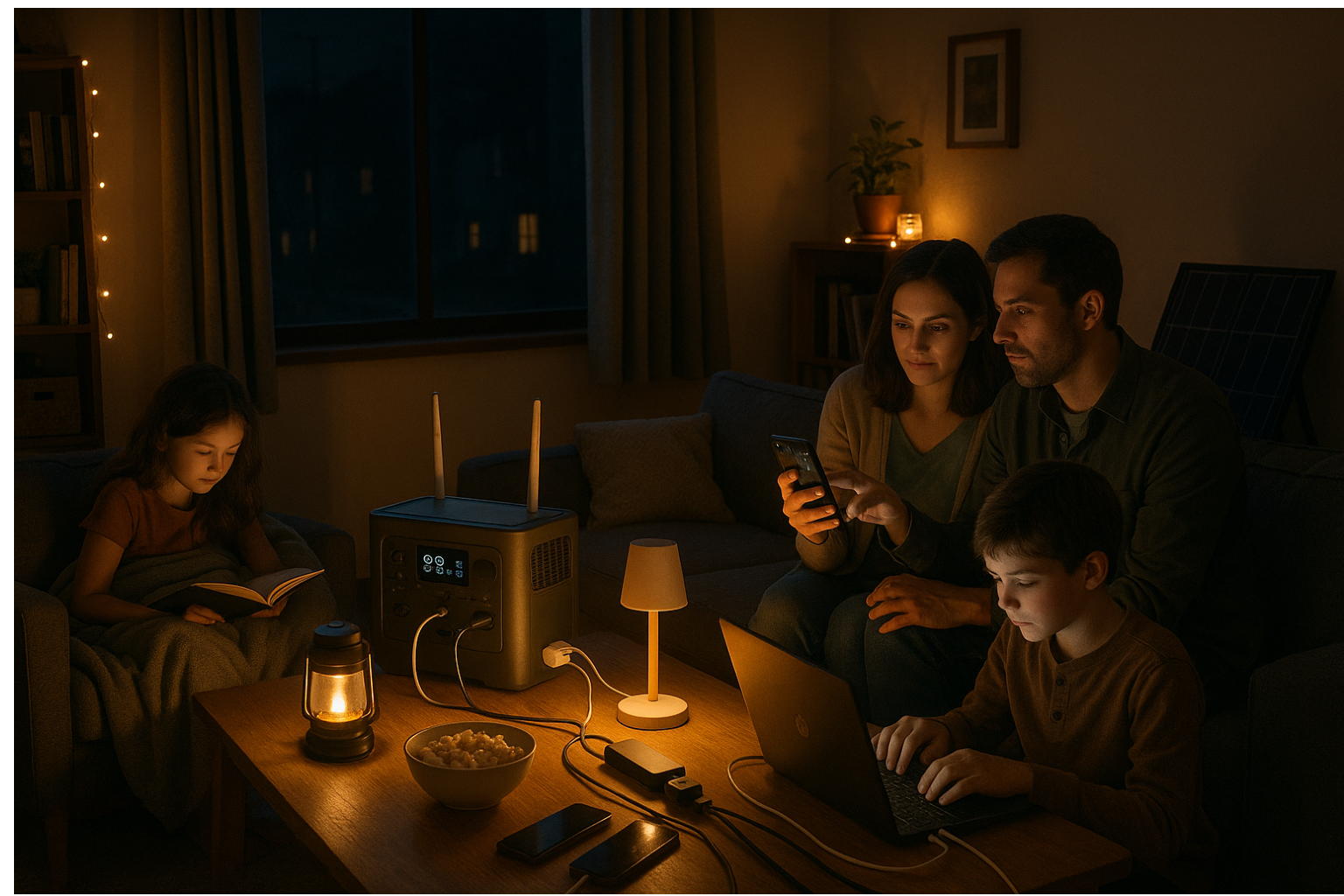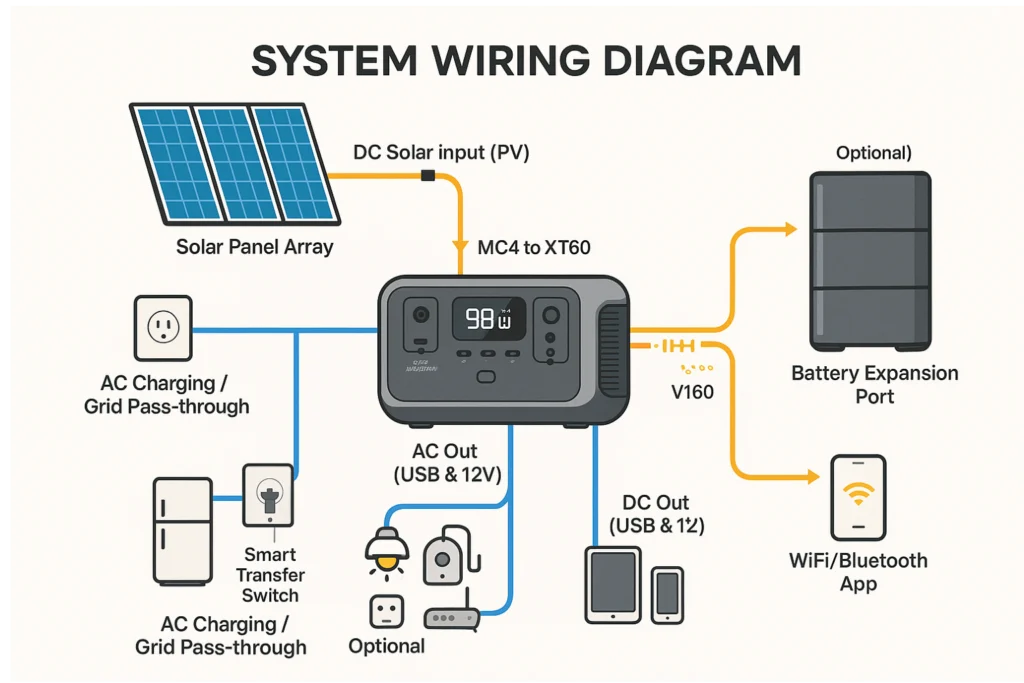Discover clean, silent, and reliable home backup power for any emergency.

Why Choose Solar Generators for Home Backup Power?
- Silent and emission-free operation
- Safe for indoor use during outages
- Plug-and-play setup – no fuel or maintenance required
- Perfect for emergencies, camping, or backup power
Key Features to Consider
Battery Capacity & Output
Choose a unit with enough watt-hour (Wh) capacity and inverter wattage to run essentials like fridges, fans, lights, and medical devices. A 2kWh unit with a 2000W inverter is ideal for mid-sized needs.
Recharge Options
Look for dual-charging systems (solar + AC) and MPPT controllers. Fast AC recharge in 2–4 hours is preferable to long solar-only charging times (~8–10 hours).
Portability
Units over 60 lbs should have wheels or handles. For easy transport, choose modular or suitcase-style designs.
Output Types
Pure sine wave 120V AC outlets are essential for electronics. Additional USB-A/C, 12V DC ports, and RV ports add flexibility.
Battery Safety & Chemistry
Opt for LiFePO₄ (LFP) batteries with 3,000+ cycles. These are more durable, thermally stable, and suitable for indoor use compared to NMC batteries.
Residential Solar Generator Guide
| Standard Setup: | 500W inverter / 700Wh battery |
| Runtime Estimate: | 4–6 hours |
| Extended Setup: | 1000W / 1500Wh |
| Extended Runtime: | 10–12 hours |
| Simultaneous Use: | 1 LED light, Wi-Fi, phone charger |
| Notes: | No appliances. Light-duty power only. Ideal for renters or seniors. |
| Standard Setup: | 1500W inverter / 3000Wh battery |
| Runtime Estimate: | 5–7 hours |
| Extended Setup: | 2400W / 5000Wh |
| Extended Runtime: | 10–12 hours |
| Simultaneous Use: | Fridge, 2 lights, CPAP, phone |
| Notes: | Microwave not recommended unless used alone. Manual transfer switch advised. |
| Standard Setup: | 3000W inverter / 5000Wh battery |
| Runtime Estimate: | 4–6 hours |
| Extended Setup: | 3600W / 8000Wh |
| Extended Runtime: | 8–10 hours |
| Simultaneous Use: | Fridge, sump pump, 3 lights, router |
| Notes: | Use with essential-load subpanel. Consider solar recharging for longer outages. |
| Standard Setup: | 6000W split-phase inverter / 8000Wh battery |
| Runtime Estimate: | 5–7 hours |
| Extended Setup: | 7200W / 12kWh |
| Extended Runtime: | 10–14 hours |
| Simultaneous Use: | 1/2 HP pump, fridge, freezer, lights |
| Notes: | May need soft-start device. 240V support is required for pump surge loads. |
| Standard Setup: | 8000W inverter / 15kWh battery |
| Runtime Estimate: | 6–10 hours |
| Extended Setup: | 10kW / 20kWh+ |
| Extended Runtime: | 12–18 hours |
| Simultaneous Use: | Fridge, washer, lights, modem, induction burner |
| Notes: | Exclude HVAC unless system is scaled for it. Use ATS with smart load management. |
Common Misconceptions
- “A solar generator can run my whole house.”
Most can only power critical loads unless you buy a high-capacity, split-phase system. - “Bigger battery = always better.”
Not necessarily. A huge battery can be expensive, heavy, and slow to recharge unless sized to your needs. - “They don’t work on cloudy days.”
Modern panels generate power in low light, and the battery stores energy for later use. - “I can go off-grid with one.”
Solar generators are for temporary backup, not total grid independence – unless you massively scale up the system.
What You Should Know Before Buying
- Limited power output: Most portable units can’t power HVAC, electric stoves, or entire homes.
- High initial cost: Expect to pay $1,000–$4,000+ for quality units with decent capacity.
- Slow solar recharging: Especially during cloudy weather.
- Heavy form factor: High-capacity units can weigh 80–100+ lbs.
- Home integration: You need a transfer switch or interlock to safely connect to your panel.
Technical Setup & Electrician Tips
- Voltage compatibility: Most solar generators output 120V AC. Use dual units or split-phase inverters for 240V appliances.
- Inverter sizing: Match surge rating to your appliances. Fridges may need up to 1200W surge.
- Grounding & bonding: Use proper neutral-ground bonding when connecting to home panels via transfer switch.
- Transfer switches: A manual switch isolates critical circuits and is safer than backfeeding via wall outlets.
- Wiring panels: Use proper gauge cables (e.g. 10AWG for 30A outlets), MC4 connectors, and inline fuses for solar input.

Top Questions About Solar Generators
Can a solar generator power a whole house? Only the largest, split-phase units can. Most are ideal for running essentials like fridges and lights.
How long do they last? 10+ years with LiFePO₄ batteries. Runtime per charge depends on your load – a 2kWh unit might run a fridge for 10–20 hours.
Can I run an air conditioner? Window ACs < 6000 BTU are possible with high-wattage inverters (2000–3000W) and enough battery capacity.
How do I connect to my home panel? Use a transfer switch or interlock kit installed by an electrician. Never plug into a wall outlet (backfeeding).
Ready to Find Your Perfect Backup Solution?
Compare the best solar generators for your home backup power needs today. Compare Generators
